Blazer 9mm 115-Grain Review: The Not for Everyone FMJ

Blazer Brass, CCI Blazer, and Blazer Aluminum are all popular range ammo options for shooters nationwide. But is it any good? Well, Blazer 9mm 115-grain full metal jacket cartridges are good for the range. However, I need to add a bit more context to that before you pick up a few 500-round boxes.
You can get Blazer 9mm 115-grain ammunition HERE. Or, you can continue reading this review and ensure it’s the best option for your firearm and range days.
Blazer 9mm 115-Grain Overview
Blazer 9mm 115-grain FMJs are manufactured at the Lewiston ammo manufacturing plant in Idaho. So, if you’re looking for ammo made in the USA, you’re already off to a great start.
However, I should mention that Vista Outdoors, the owner of CCI Blazer and other ammo brands like Speer and Federal, recently sold the brands to CSG (Czeckoslavac Group), so I can’t be entirely sure of the future.
Nonetheless, CCI and Blazer's ammo haven’t let me down yet, so I do often recommend it to friends and family looking for cheap range ammo. Make sure to read our full Blazer Ammo Review to learn more about the brand.
Last weekend, I went through five magazines of Blazer Brass ammunition, and there were no malfunctions and I had some nice tight groupings. It’s reliable, and I know it’s going to feed and chamber well.
Other shooters I speak to regularly enjoy and rely on Blazer ammunition to perform, and it has a great reputation because this ammo simply works. It’s great ammo for a good price, and nowadays that’s everything we could ask for. Good ammo fires clean and straight; we want to get as much of that for as little coin as possible.
Fortunately, Blazer 9mm ammo does fall into that bucket. Blazer 9mm FMJs are similar to Speer Lawman, which law enforcement agencies often use for qualifications and training, so you know the ammo will shoot straight.
Furthermore, Blazer 9mm 115-grain has a higher muzzle velocity than the higher grain weight ammo and several other variations. Blazer 9mm ammo comes with brass and aluminum cases and also has a TMJ (Total Metal Jacket) option that’s perfect for long days at indoor ranges.
Most shooters prefer the brass casings because they’re reloadable, and since Blazer 9mm is Boxer primed these rounds are excellent if you want to handload. However, if you need to save a little money then you can get the aluminum cased variety. Just remember the aluminum cased ammo is Berdan primed, making them a poor choice for reloading.
To browse our full selection of 9mm options, visit our Blazer Brass 9mm Ammo page.
Our Blazer 9mm 115-Grain Review
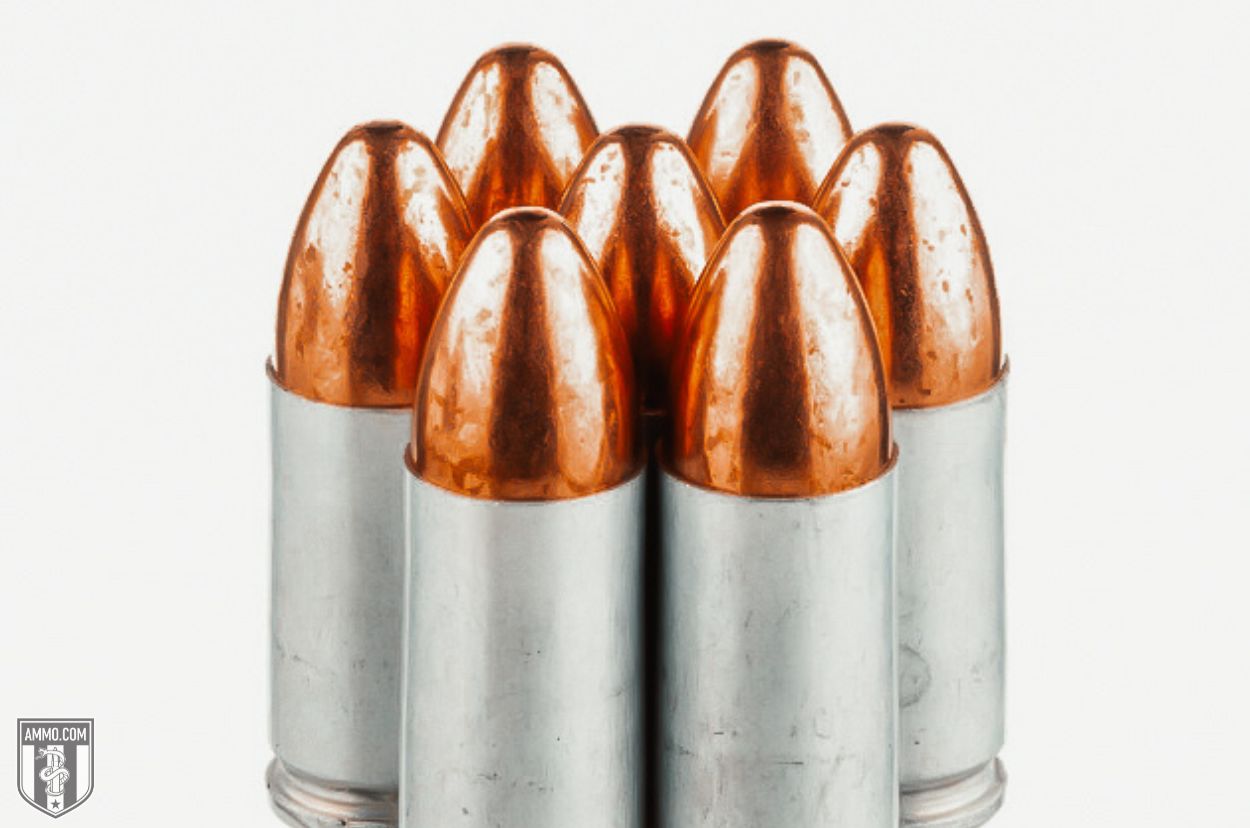
Admittedly, Blazer isn’t the most interesting ammunition. There aren't any fancy bells and whistles. And like most full metal jacket bullets, I only care if it cycles, shoots, and saves money.
However, Blazer’s value all depends on your firearm. It’s true that some firearms just hate Blazer ammunition. While some say it has lost its quality over the years, this isn’t necessarily true, but the rumors do hold some weight.
Blazer FMJs aren’t true FMJs, they are plated bullets and for most of us that’s a non-issue. However, this can cause problems if you use a ported barrel or compensator.
A plated bullet is one that, through an electrochemical process, adheres a thin copper layer to the lead core of the bullet. This completely encapsulates the lead core in copper, reducing the risk of lead exposure when shooting indoors.
However, if you are shooting a race gun with a compensator (comp) or something like a Glock 19c with a ported barrel, you'll want to go with something else like the Winchester 9mm Luger Target & Practice 115-grain bullets or the Federal American Eagle 115-grain.
Otherwise, you run the risk of shearing off slivers of the jacket material into your comp or ports and potentially damaging your firearm. And no one wants an unscheduled trip to the gunsmith!
CCI is very upfront about this on their packaging, stating that it should NOT be fired through ported or compensated barrels.
I’ve been shooting Blazer products for decades with no issues. Even Blazer Aluminum cycles fairly well in everything I’ve ever shot it out of. Naturally, if you want to hand load your ammo, it’s best to avoid the aluminum cases. But if you haven’t hit that part of your marksman journey, Blazer Aluminum FMJ 115-Grain is quality ammunition that will save a few pennies per round.
Blazer Brass 115-grain FMJs are pretty self-explanatory. They’re perfect for reloading, they have a better reputation regarding feeding and cycling than aluminum-case ammunition, and these centerfire cartridges perform just as well as any other FMJs you’ll find in the USA.
Overall, Blazer FMJs are a go-to choice for me and many other shooters who are looking for quality target practice ammo. However, it isn’t free of disclaimers, and it isn’t ammunition I’d buy in bulk before testing. If your guns do like it, it’s a great investment, but always test it first. For more options, feel free to explore our bulk 9mm ammo page for a variety of choices that might suit your needs.
What is It Best for?
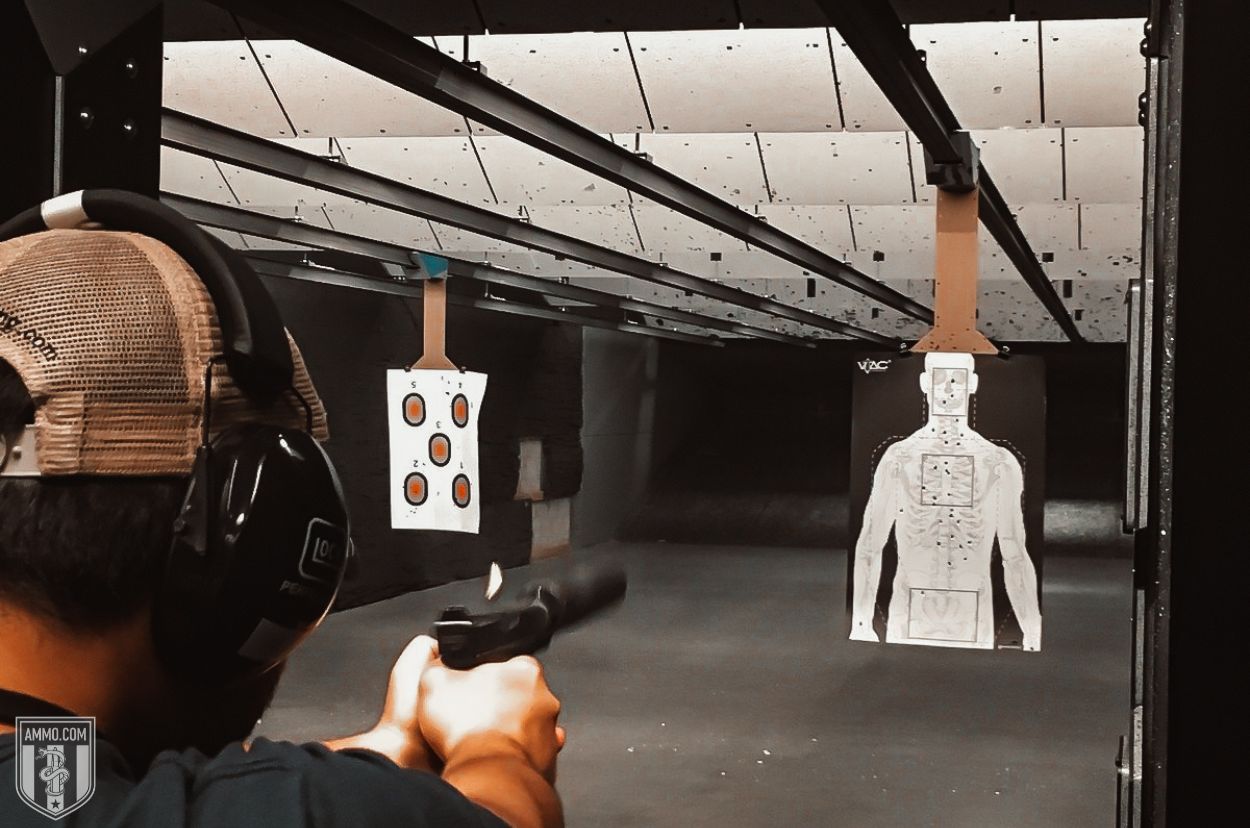
Blazer 9mm 115-grain ammo is really only good for target practice, plinking, and range days. This isn’t personal defense ammo, competition ammo, and obviously isn’t hunting ammo (I hope you aren’t hunting with a 9mm, but you never know these days).
As long as your firearm likes it, any Blazer ammo (both centerfire and rimfire cartridges) is going to be great for sighting in or getting better acquainted with your firearms without going broke.
Disadvantages
The issue with Blazer ammunition is that it isn’t designed for terminal ballistics. It shoots straight and fast, hits the target, and that’s it. It just isn’t intended for targets with tissue, and it certainly isn’t going to beat Fiocchi Range Dynamic ammo in a competition.
Pros and Cons
After years of shooting Blazer ammunition, I love it. But that doesn’t mean you will, too. Look at this ammunition's pros and cons before adding it to your cart.
Pros
- It’s quality ammo that's made in the USA
- It’s inexpensive
- It comes in brass or aluminum cases
- High accessibility
Cons
- It doesn’t perform well in all firearms
- The future of Blazer ammo is uncertain
Cartridge Specifications
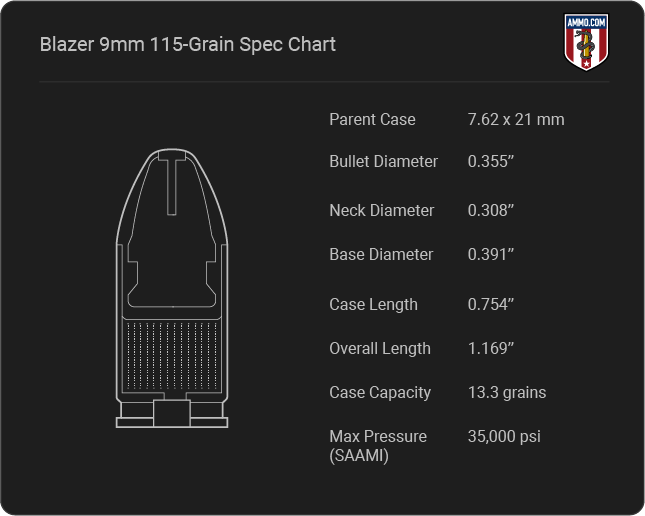
Variations
Choosing ammo isn’t always easy, unfortunately. If you’re new to the subject, I will break down each 9mm Blazer 115 grain variation so you can buy the right ammo for your favorite 9mm handgun or carbine.
Blazer Brass 9mm 115-grain FMJ
Blazer Brass 9mm 115-grain FMJ is the most popular of the two options. It’s easy to find, cheap, and it performs well. Moreover, it’s reloadable, with Boxer primers and quality brass cases, so it’s a good investment.
Blazer Brass 9mm 115-grain cartridges have 1,145 fps muzzle velocity and 335 ft-lbs of muzzle energy. The thin copper jacket encases a lead core making for fantastic plinking and target practice ammo. Furthermore, assuming you have a handgun that cooperates, the non-corrosive primers and clean-burning powders mean it’s easy on your firearm, too.
Blazer Aluminum 9mm 115-grain FMJ
Blazer Aluminum 9mm 115-grain FMJ is perfect for plinking and target practice. Although it isn’t an investment like Blazer Brass because aluminum cases aren’t useful for reloading, it can save you some money on range day.
Similar to Blazer Brass, Blazer Aluminum has a muzzle velocity of 1,145 fps, and a muzzle energy at 335 ft-lbs. Blazer Aluminum also has non-corrosive Berdan primers, which, again, aren’t great for reloading but still perform quite well.
Ballistics of the Blazer 9mm 115-Grain Bullets
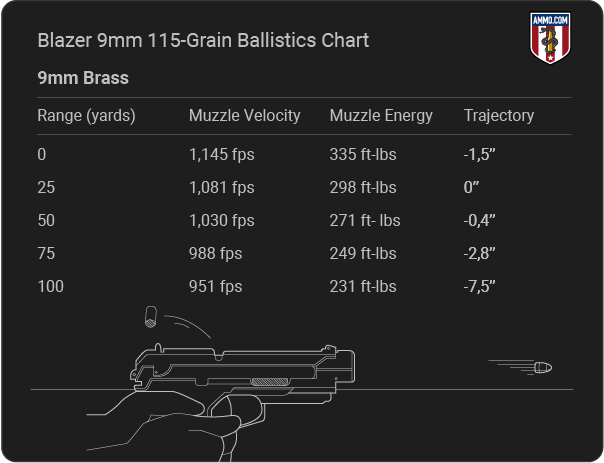
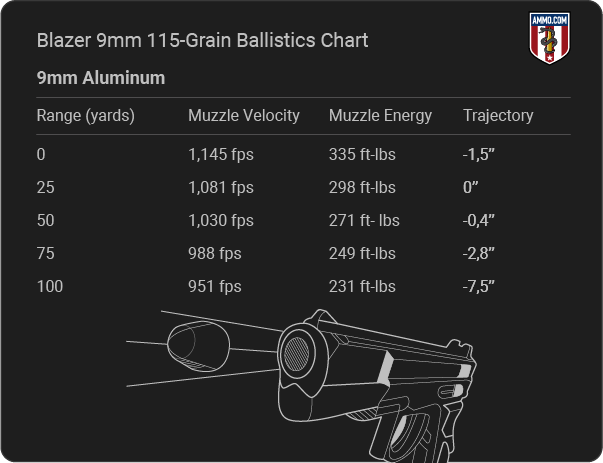
Parting Shots
I hope you’ve enjoyed this ammo review. In this economy, there’s nothing better than some good ammo at a great price. Unfortunately, Blazer 9mm can be a bit hit or miss depending on how it performs in your firearm. However, most of us have never had a problem, and Blazer tends to be a go-to range ammo choice.
When I go to the range, I don’t want to deal with jams, misfires, or malfunctions, and I do get that with most Blazer ammunition. Furthermore, Blazer can load the mags in nearly every firearm I own. From .22LR to 9mm, 380 ACP, and even .45 ACP, there’s Blazer ammunition for you. You can pick up centerfire and rimfire Blazer ammunition HERE.
FAQs
Learning about ammunition, especially a specific brand, isn’t the most straightforward task in the world. I’ve included this section to answer your most frequently asked questions.
Is Blazer 9mm 115-Grain worth buying?
Absolutely. As long as you don’t have a compensator or ported barrel, it’s great ammo.
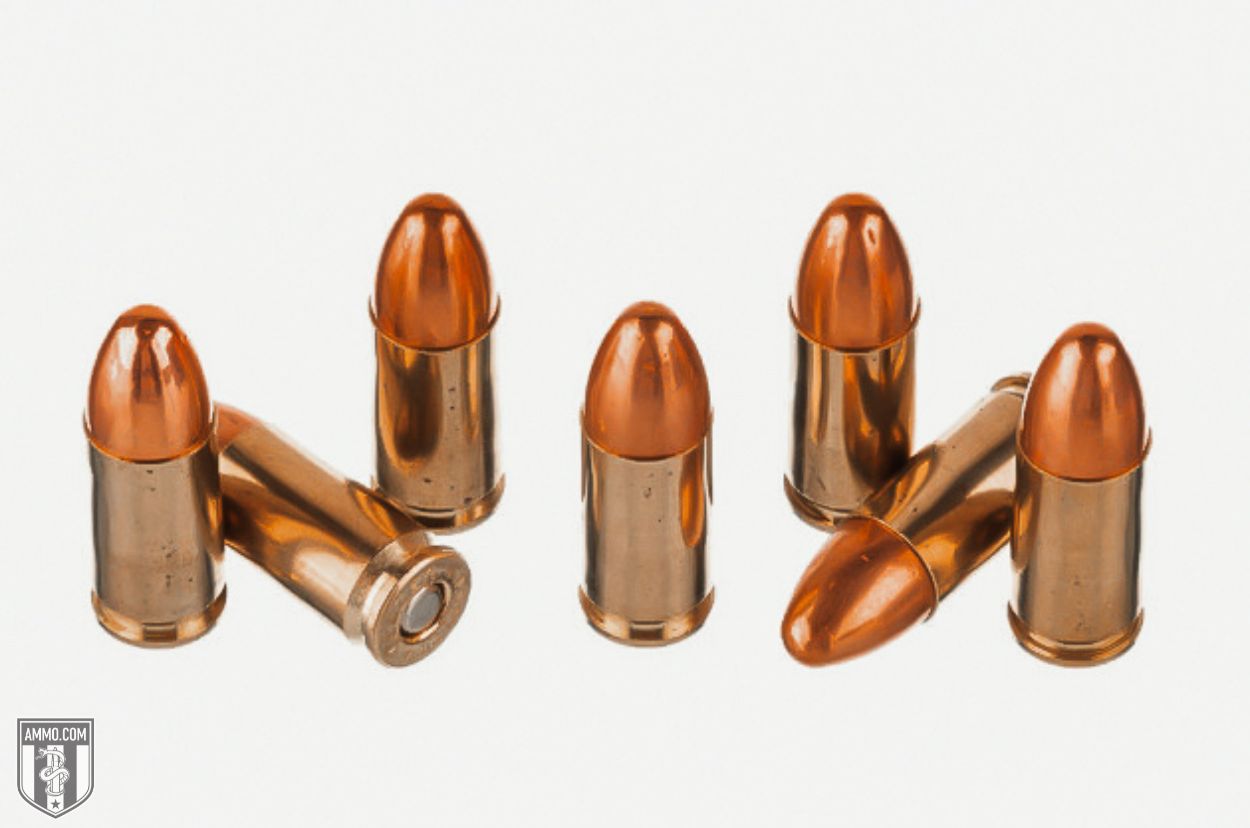
What is the range of a Blazer 9mm 115-Grain?
I have poor eyesight, so my tight groupings end at 25 yards, but Blazer Brass drops to 1,030 fps at 50 yards, so it’s possible to push it that far.
Does Blazer make hollow-point ammo?
No, Blazer does not offer hollow point loads in 9mm at this time. For self-defense ammo I tend to stick with the Federal HST or Hornady Critical Defense.
Is CCI Blazer Brass and Blazer Brass the same thing?
Yes. CCI is the manufacturer of this handgun ammunition, and Blazer is the identifier.
Can I buy Blazer 9mm 115-grain ammo in California?
Yes. Although you must undergo a background check to get it, you can buy it in California.
Is this good self-defense ammo?
No. You don’t want to keep this handgun ammo in your concealed carry or self-defense firearms. This ammo is for target practice and plinking only.
Will this ammo work in a Ruger PC Carbine autoloading rifle?
Yes. You shouldn’t have any trouble with Blazer 9mm ammo in carbines.
What’s the difference between a 9mm Luger and a 9mm Parabellum?
There’s no difference in specs between the 9mm Luger and 9mm Parabellum. Both cartridges are 9x19mm.
Are Blazer 9mm Luger 115-grain FMJs round nose bullets?
Yes, Blazer loads all of their 115 grain 9mm Luger ammo with round nose bullets.
Ammunition Reviews
- Federal Punch Ammo Review
- Magtech 5.56 Ammo Review
- Hornady 6mm ARC Ammo Review
- Hornady LeveRevolution 30-30 Ammo Review
- Hornady Superformance 6.5 Creedmoor Ammo Review
- Hornady Critical Duty 9mm Ammo Review
- Federal 22LR AutoMatch Ammo Review
- Golden Tiger 7.62x39 Ammo Review
- Federal Non-Typical Ammo Review
- CCI Blazer Aluminum 9mm Ammo Review
- Hornady SST Ammo Review
- Aguila Minishells Review
- Federal American Eagle Ammo Review
- Hornady American Whitetail Ammo Review
- Rio Shotgun Shells Review
- Hornady Frontier 5.56 Ammo Review
- Aguila .22LR Ammo Review
- Federal Training Ammo Review
- Hornady Critical Defense 9mm Review
- Federal Hydra-Shok 380 Review
- Wolf Military Classic 7.62x39 Review
- Federal Syntech Review
- Hornady Critical Defense Review
- Hornady SST Muzzleloader Bullets Review
- Federal Hydra Shok 12 Gauge Slug Review
- Hornady American Whitetail 223 Review
- Hornady Black Ammo Review
- Federal Power Shok Ammo Review
- 338 Lapua Ammo Review
- Hornady American Gunner 300 Blackout Ammo Review
- Federal MeatEater Ammo Review
- Blazer Brass 380 Ammo Review
- Blazer 9mm Luger Review
- Hornady LeveRevolution 44 Mag Review
- Federal Independence Ammo Review
- PMC X-TAC 5.56 Ammo Review
- Hornady Superformance 30-06 165gr SST Review
- Federal Champion 9mm Ammo Review
- Blazer Brass 9mm Ammo Review
- Magtech 9mm 124gr Ammo Review
- Magtech 308 Win 168gr HPBT Ammo Review
- Sellier and Bellot 9mm 124gr Ammo Review
- Rifle Line Ammo Review
- Wolf Performance 7.62x39 Ammo Review
- Wolf 6.5 Grendel Ammo Review
- Sellier and Bellot 300 Blackout Subsonic Ammo Review
- Magtech 45 ACP Ammo Review
- Brown Bear 223 Ammo Review
- Hornady Full Boar 223 Ammo Review
- Federal Hydra Shok 9mm Review
- 270 Hornady American Whitetail Review
- Hornady American Whitetail 308 165-Grain Review
- Blazer 9mm 115-Grain Review
- Hornady Black 6.5 Grendel Ammo Review
- Hornady 300 Blackout 190 Gr Sub-X Review
